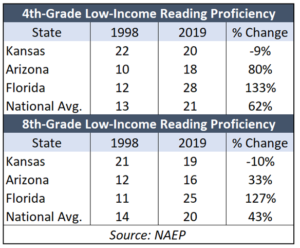[vc_row][vc_column][vc_column_text]The Kansas Association of School Board’s June 14 report on the Governor’s Education Council tells you everything you need to know about the future of K-12 education, and it’s not pretty. The Education Council measures success in dollars, not improving academic achievement.
Governor Kelly appointed two retired school superintendents from Kansas City and Dodge City to chair her Education Council, and both districts perennially have more than half of their high school students below grade level. The solution school districts talk about treat kids as little more than dollar signs, but the solution students need is choice, transparency, and accountability. Money matters in terms of how it is spent, but without choice, transparency, and accountability, school officials will do as they have in the past and produce the same unacceptable results.
Per-student funding increased much faster than inflation since 1998, but outcomes remain stubbornly low, as shown in the chart below. State assessment results also show that Kansas has more high school students below grade level than are proficient.

Florida’s combination of choice, transparency and accountability helped all public school students improve. Students of color and those from low-income families are seeing the most significant gains, and their progress is dramatically above the national average.
 In fourth-grade reading, Florida’s low-income students jumped from 12% proficient to 28% between 1998 and 2019, while the national average improved from 13% to 21%. But results declined in Kansas from 22% to 20%.
In fourth-grade reading, Florida’s low-income students jumped from 12% proficient to 28% between 1998 and 2019, while the national average improved from 13% to 21%. But results declined in Kansas from 22% to 20%.
Eighth-grade proficiency dropped from 21% to 19% for Kansas, while proficiency more than doubled in Florida, going from 11% to 25%.
Arizona, another state with robust choice options, also recorded significant gains for low-income students.
Choice, transparency, and accountability for Kansas
The Legislature is making progress – this year passing open enrollment, a third-grade literacy provision, and building needs assessment requirements – but much more action is needed.
State-funded education savings accounts for all students would allow parents to decide which school best suits their child’s needs. The ability for parents of all income levels to ‘vote with their feet’ forces school districts to ‘up their game’ and compete will benefit all students, just as it has in Florida and Arizona.
Curriculum transparency or some version of a Parents Bill of Rights, affirming parents’ right to have the primary say in how their children are educated, passed both chambers this year, but the House was unable to override Governor Kelly’s veto.
Florida and other states hold education officials accountable with an A-F grading system that translates state assessment scores into labels everyone understands – A, B, C, D, and F. Only 21% of Florida schools received an A or a B, and 28% received a D or an F in 1999. That accountability created pressure on schools to improve, and they responded. By 2002, about half received an A or a B, and only 11% were D/F schools. Florida raised the A–F standards in 2002 to make it more challenging to get high grades, and they raised standards eight more times by 2016. As of 2018, 58% are A/B schools, and only 7% are D/F schools.
The Kansas public school system won’t change by itself
Parents may naturally assume that the public education system is working to resolve low achievement. But education officials routinely take actions to benefit the system and the adults who work in it, to students’ detriment.
School districts ignored state law requiring annual building needs assessments. A legislative audit concluded that most of the at-risk funding intended to help low-income students “was used for teachers and programs for all students and did not appear to specifically address at-risk students as required by state law.” The State Board of Education is de-emphasizing academics and local officials ignore the Department of Education’s guidance on allocating money to Instruction.
And while professing their devotion to ending racism and discrimination, education officials perpetuate race-based and income-based educational discrimination.
Time and again, the public education system demonstrates that legislators must intervene with choice, transparency, and accountability to give kids a fighting chance to be successful in life.[/vc_column_text][/vc_column][/vc_row]




